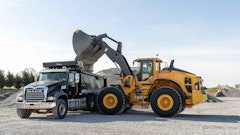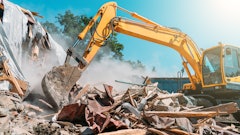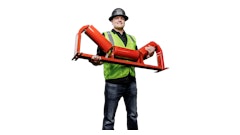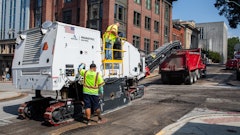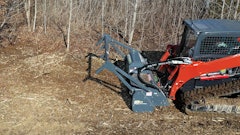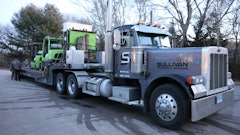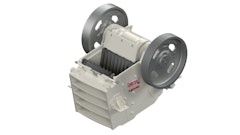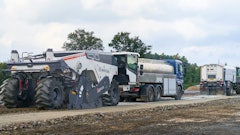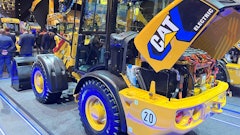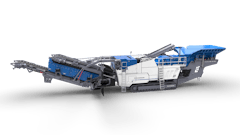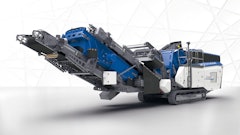
Asphalt producers/contractors continue to leverage the value of reclaimed asphalt pavement (RAP) by investing in equipment to process that resource to be incorporated in new mixes for commercial and state agency customers. Rising material costs -- both virgin aggregate and liquid asphalt cement binder -- have encouraged both producers and customers to consider the cost-savings benefit of RAP mix designs.
Many state department of transportation agencies have gained an increased acceptance of RAP designs, realizing they not only save money and expand budgets, but also that they perform as well as virgin mix designs.
For most asphalt production operations, a horizontal shaft impactor and screen to size material is all that's needed to process old asphalt. Milled RAP material can quickly be processed with a screen, with 80% of the millings passing through the ½-inch minus openings.
Larger material can then be moved through a closed-circuit conveyor system to a crusher for further processing before being returned to the screen. A horizontal crusher will sufficiently break down larger particles without crushing the aggregate content.
For asphalt producer/contractors who want better control over their ability to add maximum RAP content to their mix designs, a crushing/screening system that fractionates (separates) the material components of the RAP is considered the best way to go.
Without the capability to fractionate, most producers/contractors typically add 15% to 20% RAP to their mix designs. If DOT designs allow for more, especially in base course mixes, a fractionating system is the only way to control the actual material components of the old RAP you want to add back into the new mix.
Whenever you begin to add more than 20% RAP into a hot mix or warm mix design, fractionating old material into two sizes (generally ½-inch to ¼-inch and ¼-inch minus) not only controls the actual quantity of material size, it also allows you to more precisely determine the amount of liquid asphalt cement that old material contains.
Having that control minimizes segregation between old and new material and allows more control over the air void content of the mix you're producing. A high-frequency fractionating system works best to efficiently separate fine material (1/4-inch and smaller) from the RAP you're processing.
Working with both
Troy Kutz, vice president of the materials division for Williams Charles Construction of Loves Park, IL, says he's had experience with both types of asphalt recycling equipment and both have worked well for the purpose intended.
Located 60 miles northwest of Chicago, Williams Charles Construction operates four asphalt production facilities and portable UltraMax 1200-25CC Eagle crusher to process RAP for the four asphalt plants. The Eagle is a closed-circuit crushing and screening plant with a vibrating grizzly feeder and a double-deck screen designed to produce two cubical spec products in a single pass.
"The Eagle crusher works fine to process asphalt down to the ½-inch minus IDOT (Illinois Department of Transportation) requirements for acceptable RAP, and we'll move it from plant to plant to process 6,000-7,000-8,000 tons of RAP at a time," Kutz says.
"We generally don't like to process more than that simply because piles of RAP tend to bind together into larger chunks if left unused for any length of time," he continues. "In an average year we'll process 75,000 to 125,000 tons of RAP depending on the jobs and the spec requirements for allowable RAP content. Also, state projects only allow us to recycle millings from state highways back into new mix designs."
Williams Charles first experience with fractionating RAP came last year while working on the Illinois Tollway I-90 project near Rockford.
"We hired a contractor to provide the fractionating service in order to produce mix designs that allowed 40-45% RAP," Kutz says. "Typically, IDOT allows up to 30% RAP (1/2-inch minus) in binder mixes for state project, but the Tollway allowed 40-45% FRAP."
During this past season on the project, Williams Charles rented an Astec ProSizer 2612V fractionating system to process its own FRAP content. The closed-circuit mobile plant incorporates a double-deck PEP Vari-Vibe high frequency screen with a horizontal shaft impactor crusher.
"Even though it allowed us to increase the RAP content of the mixes designs we produced for the project, material specifications prevented us from using about a third of the material that the fractionating process produces," Kutz says.
"Fractionating does separate the material components into more precise sizes, but the Tollway had specific requirements that limited the material sizes we were allowed to use in the mixes to construct the new roadway," he explains. "So, from that aspect, fractionating did limit 100% usage of a RAP stockpile. But customers like the Tollway are moving toward FRAP as a way to save money and be more environmentally conscious."
In general, however, Kutz, who's been with Williams Charles for the past 20 years, says increasing RAP content in asphalt mix designs has been very positive for the company, its customers, and the environment.
"We're saving natural aggregates and we're saving liquid asphalt binder, and that benefits everyone," he notes. "It helps us to remain competitive and it helps reduce the amount of virgin aggregate we pull out of our quarries. That definitely makes recycling old asphalt pavements a winning proposition for us, our customers and taxpayers who pay for new roads and want a minimal impact on their environment."
Whether you invest and operate a basic crusher/screen system or a more sophisticated fractionating system, the bottom line is increasing RAP to lower your operating costs while providing customers with a lower-cost, high-quality mix.
Increasing material costs will continue to challenge asphalt producers/contractors and their customers. Investing in crushing/screening equipment benefits both and also makes both better environmental stewards by recycling existing asphalt pavements to reduce land fill requirements of old millings (as well as asphalt shingle rejects and old asphalt shingles that many asphalt production facilities can now incorporate into the mixes they produce); consequently reducing the consumption of new virgin material resources.







